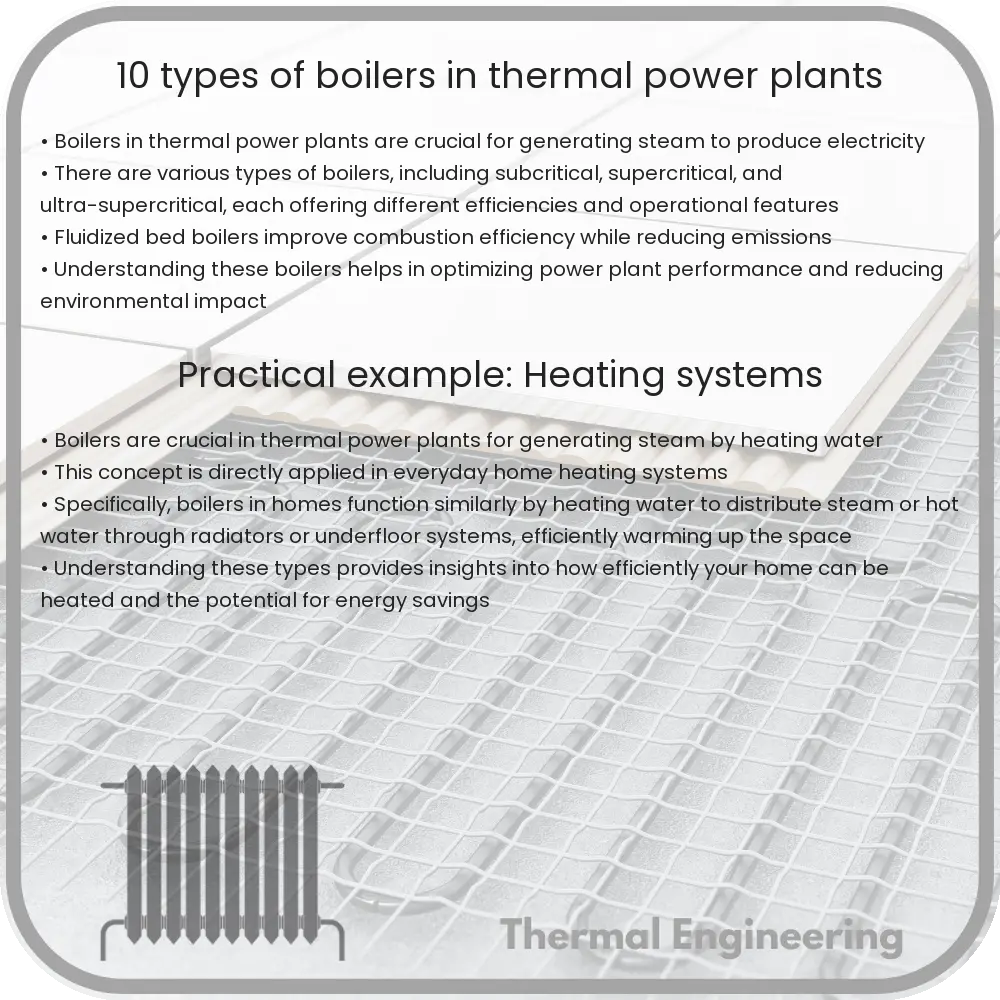Learn about the various types of boilers used in thermal power plants and their impact on plant efficiency and longevity.

Overview of Boilers in Thermal Power Plants
Boilers are critical components in thermal power plants that generate steam by heating water. This steam is then used to drive steam turbines which produce electricity. The efficiency, capability, and longevity of a power plant are significantly influenced by the type of boiler it employs. This article explores ten common types of boilers used in various thermal power plants around the world.
Types of Boilers Used in Thermal Power Plants
Each type of boiler has distinct characteristics and is suited to specific applications and conditions. Here, we delve into the most widely used boilers in the setting of thermal power generation.
- Fire Tube Boiler: In fire tube boilers, the combustion gases pass inside boiler tubes, and water is circulated outside these tubes. This type is typically used in smaller plants, where space and initial costs are more critical factors.
- Water Tube Boiler: Unlike fire tube boilers, water tube boilers circulate water inside the tubes with the hot flue gases enveloping the outside of the tubes. They can generate steam at higher pressures and are effectively used in large power plants.
- Packaged Boiler: These boilers are usually small in size and compact, making them easy to transport and install. They are mostly used in locations where space is limited, and small capacity steam requirements.
- Stoker Fired Boiler: These use mechanical means to feed solid fuels into the furnace and to manage the combustion process. They’re suitable for biofuels, coal, and other solid materials.
- Pulverized Fuel Boiler: Most commonly used in large thermal power stations. These boilers burn powdered coal, achieving a higher efficiency due to the fine particle size and higher surface area for combustion.
- Fluidized Bed Boiler: In these systems, fuel is burnt in a bed of hot, inert particles significantly enhancing the combustion efficiency. This type of boiler is effective for burning low quality fuels with high moisture content.
- Oil and Gas Fired Boilers: These boilers are predominantly used where oil and gas are available readily and in plants where biomass and coal facilities are not viable.
- Waste Heat Recovery Boiler: These boilers recover heat from the exhaust of turbines, industrial processes, or sometimes from the combustion of fuels. This type is particularly important in improving energy efficiency and reducing carbon footprints.
- Circulating Fluidized Bed (CFB) Boiler: An advanced type of fluidized bed boiler, CFB boilers allow for the uniform distribution of fuel and limestone during combustion, reducing emissions of nitrogen oxides and sulfur dioxide.
- Electric Boiler: These generate heat using electricity instead of the combustion of fuels. They are commonly used in areas with shortages of fuels and stringent emission regulations.
Choosing the Right Boiler
Choosing the appropriate boiler type for a thermal power plant depends on several factors including, but not limited to, the fuel type, the plant’s capacity, emission regulations in the area, and the available space. Engineers must evaluate both the upfront costs and the operational efficiencies when selecting a boiler for a power plant. With advancements in technology, newer types of boilers with enhanced efficiencies and lower emissions are continually being developed.
Conclusion
Understanding the different types of boilers used in thermal power plants helps in appreciating the complexity and the ingenuity of the power generation industry. It is fascinating how engineering solutions like these have evolved and adapted to meet the growing demands for energy while also considering environmental impacts.
With ongoing advancements in boiler technology, future thermal power plants are set to be more efficient, more reliable, and more environmentally friendly. The choice of boiler is pivotal in this regard, underlining the crucial role of engineering expertise in the quest for sustainable energy solutions.